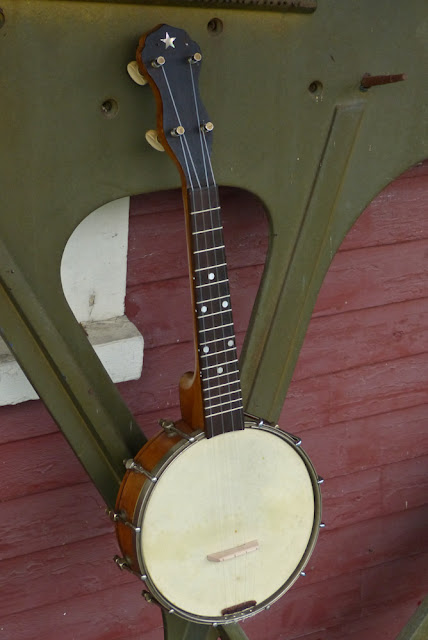1920s Lyra Banjo Ukulele
This banjo uke is "standard" in many ways -- 13" soprano scale, 7" rim, and maple build -- though it has a "back-plate" resonator and an interesting neck profile (narrower and a deeper C-shape) to set it apart. My work was the usual -- a fret level/dress, new bridge, replacement hardware, and general cleaning and setup. It's in good health and plays spot-on at 1/16" at the 12th fret. I was surprised at the darker/mellower sound coming from this, but part of that has to do with the somewhat thicker-than-usual skin (original) head.
I sort-of think this may have been a Regal, but failing that, don't really have any other ideas save Lange. It was branded "Lyra" at the headstock (more on that in a bit) and it has a curiously-heavy tension hoop and fretboard extension that are both a little unusual for what seems to be a rather average, though well-built, build.
The headstock is that nondescript "princess crown" shape that I've seen on both Regal and Lange-made products from the 20s, and used on a vast number of "house brand" instruments. Note the two tack-nails at the top of the headstock and next to the pearl star -- that was for a dilapidated celluloid tag with the "Lyra" branding printed on it. I took it off since it was cracked and also to show-off the star that was hiding under it.
The two-piece maple neck is in good shape (nice and straight) and has a stained-maple fretboard with tiny old vintage frets. I added side dots and strung this with fluorocarbon strings.
The neck, as noted earlier, is a more tenor banjo/mandolin shape which could easily support steel strings. Its narrower width, overall, also makes it useful for sliding closed-position chords.
I was out of 5/8" bridges so I made this maple one up on-the-quick. I'll be including an additional standard-issue maple/ebony 5/8" bridge along with the uke, though. The leather pad under the strings is for muting overtones.
The resonator back has a birdseye maple veneer that looks pretty sharp. The resonator itself is suspended from the rim so sound can leak out from its edges and I've used some old square nuts as spacers to do so (the original -- probably vulcanized rubber -- spacers were long gone).
I didn't grab a picture of the rim's inside but this has the usual dowel-stick setup and it uses a single screw to attach the neck to the rim rather than a neck brace.
The original friction pegs are still going strong.
Rather than installing a tailpiece, I drilled some tiny holes through the tension hoop to mount the strings. I like the clean look and secure stringing this gives -- and it eliminates one more extra bit of hardware that can rattle if not kept-up. The original end-bolt is there, however, if a tailpiece becomes desirable (the original was missing).
The rim hardware (shoes, hooks, nuts) on the "knee" or "treble" side of the instrument are all later replacements except for one hook/shoe/nut combo.
















Comments